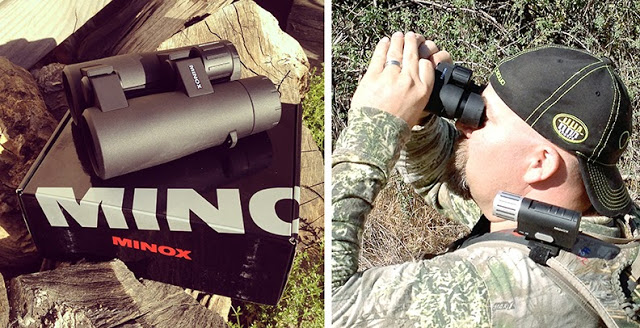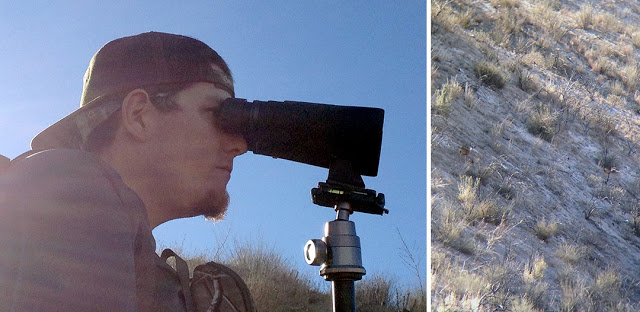Over the years, I have truly grown to appreciate the benefits of quality optics for bowhunting. I have been bowhunting for nearly 30 years, but I never truly grasped the importance of good optics until roughly six years ago. That’s when I started hunting the foothills and deserts of Southern California. The value of my optics far outweighs the price tag and it took some convincing.
Quite honestly, I figured any binoculars would work. When I would go in search of deer, I used my $25.00 pair and couldn’t figure out why I would get headaches all the time. Eye strain, eye fatigue, and cloudy lenses are some of the reasons why. The simple truth is you get what you pay for! There is a reason why quality binoculars are more expensive.
When I began hunting in NY, I didn’t feel the need to routinely use binoculars or a spotting scope. I was 20 feet up in a tree waiting for a whitetail to walk by. I used binoculars only to locate deer in the farmers’ fields in hope I could set up a stand or ambush them from another direction. After my move to California, I learned quickly that the binoculars I had were useless for hunting the West. Out here it’s about spotting your animal from a long distance (sometimes two miles or more) and then making an approach to spot and stalk. Plus, like many states, we have an antler restriction and having a quality binocular or spotting scope will help you determine if that buck is legal or not.

As a member of the MINOX Hunting Optics Adventure Team, I am going to give you a taste of what I am using for bowhunting here in California. For my hog hunting and deer hunting, I am utilizing the MINOX BL 10×44 binoculars. They are lightweight, crystal clear and are an incredible tool in helping me effectively spot animals. I don’t get eye fatigue and often glass for hours with them.

For long range acquisition, my hunting partner, Brett has been field testing the MINOX BL 15×56 binoculars mounted to a tripod. He finds them extremely useful and has been able to determine the legality of more than a few deer. Unfortunately, the interpupillary distance (distance between the centers of the pupils of your eyes) doesn’t allow me to comfortably appreciate the 15×56 binoculars. That being said, most of my long range viewing will be through a spotting scope, like the MD50. I know plenty of other hunters that prefer spotting scopes. While I am a believer that you can judge an animal better by using two eyes vs. one, in this case genetics forces me to make an exception. Be sure to try out binoculars before you buy to be sure you are comfortable with them.
Caring for your optics is very important. Next to your archery set-up, care of your optics should be next on your priority list. If you are like many who use the manufacturer provided neck strap or a simple harness to carry your binoculars, you should use the lens covers the manufacturer provides. If you find them cumbersome (like me), you can remove them for each hunt, but be sure to protect them when in the field. I prefer to use a fully-enclosed chest pack like the Binocular Chest Pack from Badlands. It allows easy, zipperless access to the binoculars, but also protects them when kicking up sand and dirt. If you do happen to get sand on them (especially in the eyecups), be sure to clean out the dirt and grime after each hunt. Sand will scratch up your lenses fast! Don’t use a cloth and try to rub the dirt off! Instead use some sort of compressed air to blow out debris, thus protecting your investment.
Utilizing a tripod with your binoculars is a key component when scouting for animals out West. Mounting your binoculars to a tripod reduces the ‘shake’ to nearly zero and you can keenly focus on more things. Hand holding your binoculars are fine, but not entirely steady, causing your eyes to dance around. It is a must have for hunters having to glass long distance and for long periods of time. A tripod will turn a decent pair of binoculars into a better pair of binoculars.
As a hunter and a photographer, I prefer a carbon fiber tripod. First off, it is a quiet material and doesn’t make a clanking sound if you accidentally hit it. Second, there is little to no glare when the sun hits the legs. Aluminum (silver or black) will cast a glare, allowing animals to spot you easier. Sure, a carbon fiber tripod weighs more and can be more bulky than aluminum, but I love how it performs in the field.
The best advice I can offer to any hunter looking to purchase quality optics is to buy the best optics you can. Don’t settle on something cheap. If you have to save for a couple years, do it. You do get what you pay for and purchasing a high quality binocular and spotting scope will drastically improve your ability to clearly view animals while hunting. Take is from a guy who has been there. Once you have them, take care of them and they will last you a lifetime.
Be First to Comment